So…, this was interesting. This was scary. This was exciting. This was rewarding.
I love tamales, particularly the Mexican and, of course, the Panamanian versions; I just never tried making either. The task seems daunting and too tedious to get involved. But then, I love a challenge and I was ready to take this one on. I started with the ones from Panama ‘cuz, well. You know. That’s where I’m from.
Tamales are usual fare for any celebration, Christmas, NYE, weddings, parties. In Panama, they come in a variety of sizes, but most commonly they are large enough to make it a full meal. They’re made of corn, filled with chicken, pork and more recently, seafood. Ours are different in that they are cooked in a leaf from a plant called bijao. Don’t ask me what else it produces, because I have no clue. But the leaves look a lot like bananas leaves, however the taste is quite different. You know what’s sad? I don’t remember what they taste like. That’s depressing.
Unfortunately, the leaves aren’t available stateside, so I had to improvise and replace them with foil paper. I don’t much enjoy the taste banana leaves impart on food, which is why I didn’t use those. I also forgot to get prunes, but we will survive. I promise you. You know what I found out once I made this? It ISN’T as tedious as I thought it would be, nor was it all that time-consuming.
Are you ready? Here goes nothing–well, something amazing, but that’s not the saying. Y’know what I’m sayin’? This recipe will yield about 20-25 tamales, and they will freeze quite well.
Tamales Panameños
Ingredients
2 lbs yellow corn hominy, dry
2/3 cp pork fat or vegetable oil
2 tsps sea salt
2 pkts Sazón
4 lbs pork short ribs
1 pkt Sazón
2 onions, chopped
1 large can tomatoes, diced
4 culantro leaves OR 1/2 cp cilantro, chopped
4 garlic cloves, minced
2 tsps sea salt
2 tbsp tomato paste
2 tsp dried oregano
1 bottle beer
1 tsp habanero sauce (optional)
12 oz pitted prunes, about 25
1-1/2 cp seedless raisins
1 cp pitted olives
about 1/4 cp capers
1/2 cp roasted red pepper (pimentos), sliced
Aluminum foil cut into pieces about 6 inches wide
Now for the method; Although I’ve listed all the ingredients together, I will break down the process for the different components: preparing the hominy, then the pork, and putting it all together.

Corn time, baby!
Rinse the hominy and put it in a large pan, add the 2 tsps salt and bring to a boil. Lower the temperature and cook for about 2 hours or until the grains are tender. Once it is done cooking, strain and rinse the hominy. Allow it to cool. Once the corn cools, you will need to run it through a grinder using the finest setting. I’m not sure if using a food processor would work, but it might do the job just fine.
For the piggy part.
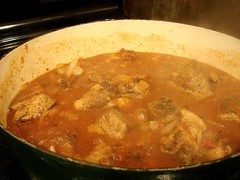 While the corn cooks, prepare the pork. Cut it into 2-inch cubes and season it with salt and black pepper. Heat a medium-sized pan and add about 1 tbsp vegetable oil and brown the pork pieces and set aside. After browning the pork, add the onions, garlic and culantro and cook until the onions are softened. Then add the tomatoes, paste, oregano, Sazon make sure to remove the drippings stuck at the bottom of the pan. Add the pork back to the pan, then the beer and enough water to cover. Bring it to a boil, put a lid over it and lower temperature to a simmer; allow it to cook for about 45 minutes or until the pork is very tender.
While the corn cooks, prepare the pork. Cut it into 2-inch cubes and season it with salt and black pepper. Heat a medium-sized pan and add about 1 tbsp vegetable oil and brown the pork pieces and set aside. After browning the pork, add the onions, garlic and culantro and cook until the onions are softened. Then add the tomatoes, paste, oregano, Sazon make sure to remove the drippings stuck at the bottom of the pan. Add the pork back to the pan, then the beer and enough water to cover. Bring it to a boil, put a lid over it and lower temperature to a simmer; allow it to cook for about 45 minutes or until the pork is very tender.
Time to put it all together.
First off, pour yourself a glass of wine, preferably red. First, you’ll need to season the corn dough or masa. After you grind it, add the pork fat, the Sazon packets and about 2 cps of the juices from the pork, don’t be shy about the onion pieces falling in. Knead all of this very well, you want to make sure it is evenly distributed. The masa’s consistency should be soft, but not runny.
The pork, it should be chunky, but not too large, so break it apart a bit and keep some of the pan sauce. Line up the raisins, prunes, pimentos, olives and capers.
Take a sheet of foil, spread about 1/3 cp or so of the masa over 2/3s of the sheet. Put a few pieces of pork close to one of the ends of the masa, put a couple of olives, capers, a prune and a few raisins. Now fold over the foil so that the rest of the masa covers the filling. Fold the foil like an envelope: first fold the top once, then the sides. Make sure to flatten the foil, you want it to be a tight seal.
Fill a large stock pot with water, drop 2 bay leaves and 3 cloves of garlic–no need to peel them. I did this because I don’t have the bijao leaves which add flavor to the tamales. This way the water will have its own flavor and will not just draw it out from the tamales. Bring the water to a soft boil and drop the tamales in one by one. Allow them to cook for 1 hour.
Remove the tamales from the water, lay them upside down to allow any water that might have seeped through to drain out. Remove the tamales from the foil packets and serve.
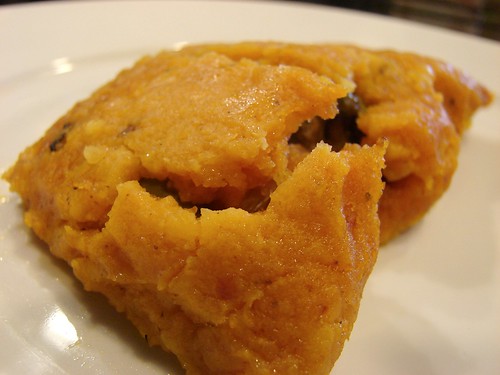
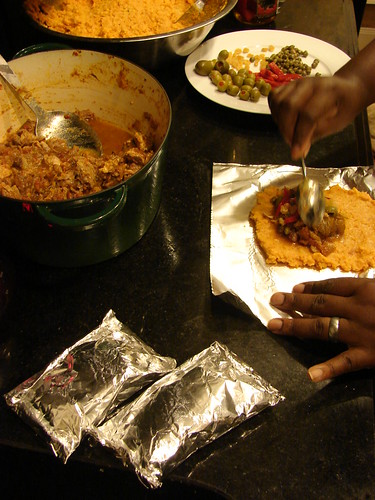
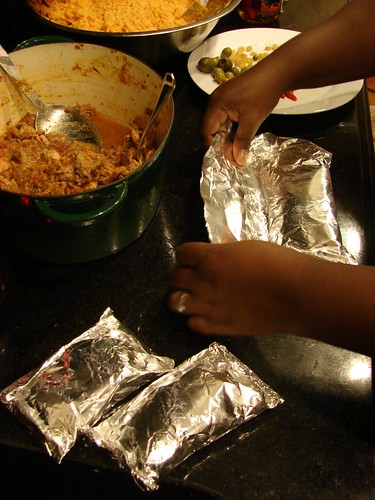
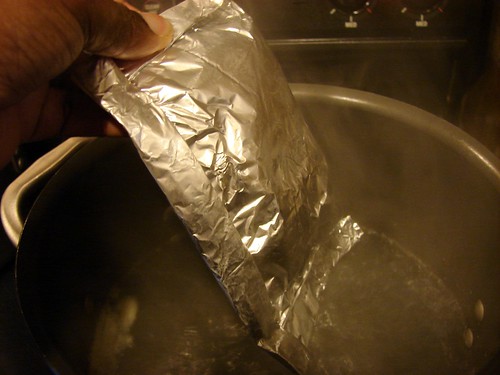
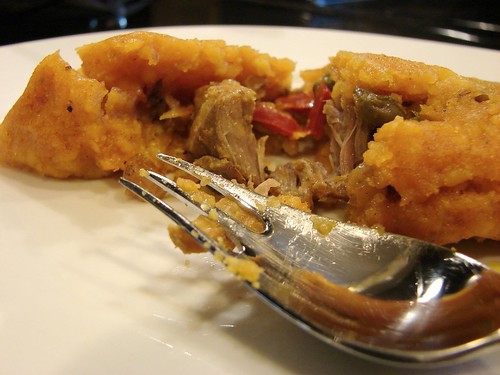
Comments ( 15 )
What is sazón?
Hi there! Sazon is sorta Latin America's version of seasoned salt. The most readily available brands are from Knorr OR Goya. It usually contains 'achiote', a seed that adds color to foods much like saffron or turmeric. There's a bit more info here. If you can't find these seasoning packets, use seasoned salt instead. And, THANKS for visiting! Anamaris
Hi, It's me again. I've craving tamales for a year and a half now that I'm considering making them myself. I'm currently living in the Philippines and Mexican, Southwestern, Central and South American ingredients are pretty hard to come by. However, I found masa harina at the supermarket. I know it's a lot of work to make tamales. If I do make this, I will be making this mostly for myself. Is it worth making this for just one person considering the work involved?
ooooh. I would say it is worth it. It may not be something you make regularly, but we all deserve to be spoiled. If you're using masa harina, you're cutting down a lot of the effort and time. Simply prepare the chicken or pork as stated, then add the pan sauce and fat/oil to the masa harina and follow the remainder of the recipe. Do let me know how it turns out!
Oh, I didn't know masa harina was the shortcut version. What exactly is hominy anyway? I used to hear it all the time when I was back home in L.A. but never quite new what it was. If I use chicken, which part would be best to use? I'm assuming it would the thighs since they have more flavor?
I should've asked, the masa harina you have, is it white or yellow? The corn we use is the yellow variety. If you're using the white masa harina, the taste will be quite different because of the preservatives in it. Anyway, it would still work. Hominy is dried corn kernels. It's not the sweet yellow corn that is so popular in the US. I would suggest you stick to dark meats for the chicken, thighs would be great, so would the legs. Of course, you get more meat from the thighs. I'm so excited you're going to try this!
The one I found is yellow. It's the 24 oz., Bob's Red Mill brand, to be exact. So does that mean you just made your own masa harina in this recipe? Sorry if that sounds like a stupid question? I've been drying my own corn husks since they're not available here. I don't think I have enough yet to make tamales just yet. If I remember, wouldn't I need at least 2 pcs. of corn husk per tamale to ensure that the water doesn't get in? So, is this 24 oz. bag of masa harina enough? Remember, it's just for me, the rest of them will be stored in my freezer for future tamale cravings.
Perfect! You want the yellow for this type of tamales. I think a 24-oz bag will probably make about 20 medium size tamales. That masa renders a lot once you had liquid to it. I made my masa out of the whole dry corn (hominy). I cooked the corn, ground it, then added the braising liquid and fat. The tamales on this recipe don't use the corn husks, but rather a type of leaf not available in the US. I sub'd the leaf with aluminum foil to steam the tamales. If you're planning on using the corn husks, I would think you'd need 2 at a minimum for each tamal--of course, this depends on the size you make them. Remember that the amount of masa you use ultimately determines the size of the tamal.
If the 24 oz. bag of masa harina makes 20 pcs. then I definitely don't have enough corn husks dried. I guess more excuse to eat corn! I've been getting strange looks from one of my neighbors for leaving the husks out to dry. As soon as I gather enough corn husks, I'll be back for more questions on the cooking part. Thanks, you been of great help so far. :)
Hi, I'm planning to make tamales this weekend. I'm going to use chicken for easier and quicker cooking time since it's pretty hot over here and I don't want my place to feel like an oven. So, if I use chicken.... .. do I boil it just enough until it's cooked or do I treat it as if I'm making chicken stock..simmer for about 2-3 hrs? ..I'm going to make this just for me, won't be sharing with anyone. 4 lbs of meat in your recipe is a lot for one person. What's a reasonable amount of chicken for 1 person to make this? ...I have fresh potted oregano (the Italian kind), do I really have to use the dried one? Thanks so much.
You would cook the chicken the same way I suggest cooking the pork here. Essentially, you're stewing the chicken. If you're making this just for you, I would make 1/2 a recipe, if it's still too much, this freezes well. I still have some left in my freezer. Fresh is always better, you may need a bit more oregano, but fresh is fine.
Forgot to ask.. sorry if the questions sound dumb but here goes... When stewing the chicken... (a)...skin included? (b)...do I remove the chicken meat from the bones before stewing and browning or do I do that after it's been simmered?
Skin and bones would be as you prefer. Personally, I would use dark meat with both skin and bones; stew it then remove the bones when cooked. If you have an objection to skin, you can leave it out, but I would definitely cook the chicken bone-in and remove after the fact. To be honest, in Panama you sometimes find tamales with the bones in.
Thanks a lot. Will be working on it this weekend. :)
Can't wait hear about the results!